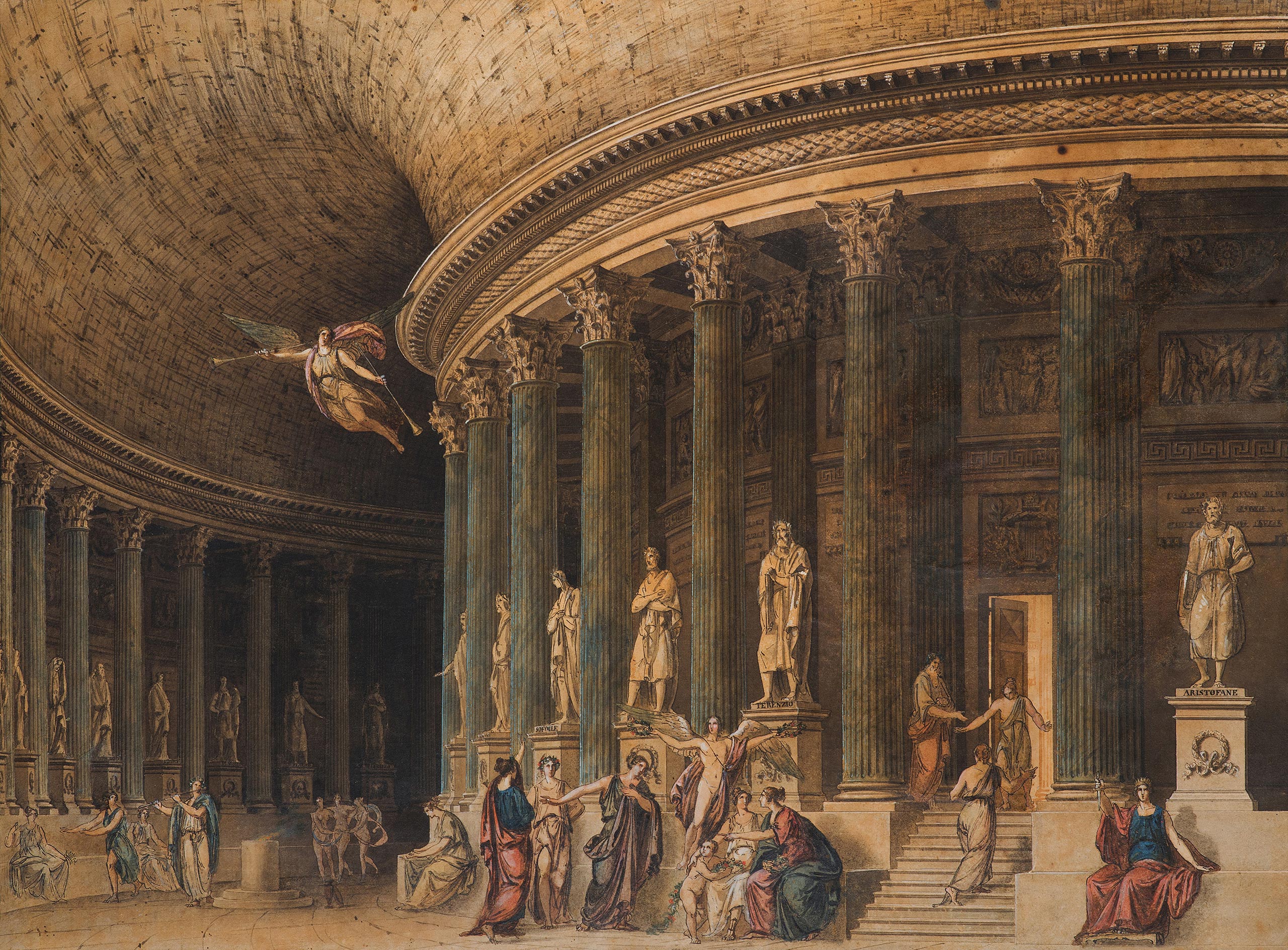
Gonzaga
Pietro di Gottardo, called Pietro
Longarone 1751 — St. Petersburg 1831
Project for a Scene Curtain for the Fenice Theatre in Venice
Watercolour and white heightening on pen and brown ink, grey wash. Inscribed SOFOCLE, TERENZIO, ARISTOFANE and other illegible names.
640 x 480 mm (25 1/4 x 18 3/4 in.)
A great theatre decorator who trained in Venice in the 1760s and 1770s, Pietro Gonzaga was deeply influenced by Tiepolo and Piranesi. He began his career in Milan, where he studied with the decorators Bernardino Fabrizio and Giovanni Antonio Galliari, and took part in the inauguration of the new La Scala theatre in 1778, with scenes for the ballet Calypso abbandonnata. His sets were regularly admired there until 1792. In the same city, he also painted sets for the Canobbiana theatre in 1779. His stay in Rome enabled him to study ancient monuments in detail, which was essential training for scenographic painting. He went on to work for numerous other theatres in Parma, Genoa, Rome and Venice, and his works were greatly admired, even often copied. He was already a famous artist when he was asked to take part in the inauguration of the new Venetian theatre, La Fenice, designed by Gian Antonio Selva. The inauguration took place on 16 May 1792 with I Giuochi d’Agrigento (The Games of Agrigente) an opera by Alessandro Pepoli set to music by Alessandro Paisiello. The libretto states that the background curtains for the opera scenes were by Francesco Fontanesi and those for the ballets by Pietro Gonzaga.
Our drawing, whose large size and degree of completion are rare in the artist’s graphic corpus, appears to be a very finished project for one of these curtains. It is described in Memoria storica del teatro La Fenice Venezia: “Cavalier Francesco Fontanesi, one of those responsible for choosing the models, painted the opera scenes, and Pietro Gonzaga Bellunese, mistakenly called Veneziano in the libretto, painted the ballet scenes. The second curtain, the ballet curtain, was a great success, executed by Gonzaga with a mastery that brought illusion to its climax. With rare simplicity, it depicts the vaulted atrium of a temple, with a circular base, whose half-open door allows a very bright light to filter in, indicating that Apollo’s
sanctuary is inside. The Muses are outside; Euterpe and Terpsichore, the most honoured, hasten with their sisters Thalia, Melpomene and Erato to celebrate their God, while fame hovers in the air, sounding Clio’s trumpets. Statues of the most famous philosophers and poets, both ancient and modern, line the interior of the building. Over the course of forty-four years, this prodigious canvas was repainted twice, because it was thought that nothing could be better than to preserve it, as a theatre set and an encouragement to the Fine Arts.”1 The Gazetta veneta urbana of 23 May 1792 also gave a detailed description of the curtain, paying particular attention to the architecture of the temple. One of Gonzaga’s other background curtains for the play, depicting a forest, was also much admired by the public.2
There are at least three sheets in which Gonzaga studied this atrium of a circular temple, also with figures but executed in a much more schematic way: the most complete is in the Hermitage in Saint Petersburg3 (Fig. 1), another was in the Ugo Sofia-Moretti collection in the 1960s4; the third, simply in pen, is on the art market (Fig. 2).5 These three drawings seem to be preliminary sketches for our project. They already include the figures, albeit in varying numbers, which is rare for Gonzaga. The idea of statues of the authors is already well advanced in the St Petersburg sketch, which specifies the names of two central authors, Aeschylus and Sophocles; they became Aristophanes and Terence in our drawing. A fourth sheet, which came up for sale at Christie’s in 2004, does not include the figures; it is of much lower quality and its attribution is uncertain.6
As early as the 1967 exhibition at the Cini Foundation, the Saint Petersburg drawing was described as the bozzetto of a Fenice curtain. The author of the catalogue, Maria Teresa Muraro, also noted that the artist executed a variant of this project for the curtain of the small theatre in Pavlovsk outside Saint Petersburg. At the beginning of 1792, even before the inauguration of the Fenice, the artist signed work in Russia, where he had gone at the invitation of Nikolai Yusupov, director of music and pageantry at the court of Catherine the Great, to become chief painter. His career flourished, and he revolutionised theatre décor with trompe-l’œil, optical illusions and dramatic chiaroscuro. He entered the Saint Petersburg Academy, opened a successful studio and received numerous commissions for stage design. When the Empress died, he was commissioned to design the funeral catafalque and the triumphal arch erected for Paul I’s coronation. For Paul I and his wife, he was responsible for the renovation of Pavlosk Park and the interior decoration of the palace, among other projects.
At least three other sheets depicting a very similar circular vestibule, but in a sketchier manner and with notable variations, are in Russia, at the Hermitage7 and at the Arkhangelsk palace-museum,8 which shows the artist’s interest in this motif, which he may have used after his work at La Fenice for other projects. The Hermitage’s Graphic Arts Department holds two hundred drawings by or attributed to Gonzaga, 130 of which are undoubtedly autographs, while the remainder must certainly be attributed to his studio. Our drawing, of spectacular size and a rare degree of finish, is therefore the most accomplished testimony to one of La Fenice’s most admired curtains, destroyed in the fire of 1836.
- Memoria Storica del Teatro La Fenice in Venezia, Venice, Giuseppe Orlandelli, 1839, p. 32-33.
- “Rettificazioni Schiarimenti ed Aggiunti alla Memoria storica del teatro La Fenice in Venezia, parte prima edita anno 1838” in Memoria Storica del Teatro La Fenice in Venezia, Venice, Giuseppe Orlandelli, 1839, p. 53.
- Hermitage museum, OP 34394, 360 x 444 mm, since 1923, formerly in the Stieglietz collection. Published in : M.T. Muraro, Scenografie di Pietro Gonzaga, Venice, N. Pozza, 1967, p. 68-69, no. 96 ; Pietro Gonzaga, esquisses et peintures décoratives, exh. cat., St. Petersburg, Hermitage museum 1980, no. 2, p. 22; Myzyka v Ermitazhnom teatre. 1786-1796 (Music in the Hermitage theatre), cat. exp., St. Petersburg, Hermitage museum 2006, no. 9, p. 18; Pietro Gonzaga, exh. cat., St. Petersburg, Hermitage museum 2011, cat. no. 89, p. 342.
- Pica (entry) in U. Sofia-Moretti, Pietro Gonzaga, scenografo e architetto veneto (1751 Longarone – Pietroburgo 1831) e l’ambiente artistico del suo tempo, Milan, Le Grazie, 1960, n° 2.
- Paris, La Nouvelle Athènes gallery, March 2024, exh. cat.
- London, Christie’s, 10/12/2004, lot 355 (black chalk, pen and brown ink, brown wash, 212 x 278 mm).
- Hermitage museum, Inv. 13528 : Panthéon : the interior of the central rotunda is visible and oculi windows have been added above the entablature.
- F.A. Sirkina, Pietro di Gottardo Gonzaga, Vie et Œuvre, 1974, no. 51, 76 et 85 and Muraro, op.cit., 1967, no. 96, p. 68-69.

